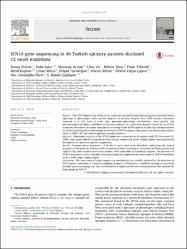| dc.contributor.author | Usluer, Sunay | en_US |
| dc.contributor.author | Salar, Seda | en_US |
| dc.contributor.author | Arslan, Mutluay | en_US |
| dc.contributor.author | Yiş, Uluç | en_US |
| dc.contributor.author | Kara, Bülent | en_US |
| dc.contributor.author | Tektürk, Pınar | en_US |
| dc.contributor.author | Baykan, Betül | en_US |
| dc.contributor.author | Meral, Cihan | en_US |
| dc.contributor.author | Türkdoğan, Dilşad | en_US |
| dc.contributor.author | Bebek, Nerses | en_US |
| dc.contributor.author | Yalçın Çapan, Özlem | en_US |
| dc.contributor.author | Gündoğdu Eken, Aslı | en_US |
| dc.contributor.author | Çağlayan, S. Hande | en_US |
| dc.date.accessioned | 2017-07-06T08:56:52Z | |
| dc.date.available | 2017-07-06T08:56:52Z | |
| dc.date.issued | 2016 | |
| dc.identifier.citation | Usluer, S., Salar, S., Arslan, M., Yis, U., Kara, B., Tekturk, P., Baykan, B., Meral, C., Turkdogan, D., Bebek, N., Capan, O.Y., Eken, A.G., Caglayan, S.H. (2016). SCN1A gene sequencing in 46 Turkish epilepsy patients disclosed 12 novel mutations. Seizure: European Journal of Epilepsy. 39, 34-43. | en_US |
| dc.identifier.issn | 1059-1311 | |
| dc.identifier.uri | https://hdl.handle.net/20.500.12294/841 | |
| dc.identifier.uri | http://dx.doi.org/10.1016/j.seizure.2016.05.008 | |
| dc.description | Yalçın Çapan, Özlem (Arel Author) | en_US |
| dc.description.abstract | Purpose: The SCN1A gene is one of the most commonly mutated human epilepsy genes associated with a spectrum of phenotypes with variable degrees of severity. Despite over 1200 distinct mutations reported, it is still hard to draw clear genotypephenotype relationships, since genetic and environmental modifiers contribute to the development of a particular disease caused by an SCN1A mutation. We aimed to initiate mutational screening of the SCN1A gene in Turkey and advance further our understanding of the relationship between the SCN1A sequence alterations and disease phenotypes such as GEFS+, DS and related epileptic encephalopathies. Methods: Mutational analysis of the SCN1A gene was carried out in 46 patients with DS, late-onset DS, GEFS+ and unspecified EE using either direct Sanger sequencing of the coding regions and exon/intron boundaries or massively parallel sequencing. Results: Nineteen point mutations, 12 of which were novel were identified, confirming the clinical diagnosis of the patients. Patients with a mutation (either truncating or missense) on linker regions had significantly later disease onset than patients with mutations in homology regions. The presence of SCN1A mutations in two clinically unclassified patients supported the association of SCN1A mutations with a wide range of phenotypes. Conclusion: The conventional Sanger sequencing method was successfully initiated for the detection of SCN1A point mutations in Turkey in epilepsy patients. Furthermore, a modified strategy of massively parallel pyro-sequencing was also established as a rapid and effective mutation detection method for large genes as SCN1A. | en_US |
| dc.language.iso | eng | en_US |
| dc.publisher | Elsevier | en_US |
| dc.relation.ispartof | Seizure: European Journal of Epilepsy | en_US |
| dc.rights | info:eu-repo/semantics/openAccess | en_US |
| dc.subject | Dravet Syndrome | en_US |
| dc.subject | Epileptic Encephalopathy | en_US |
| dc.subject | GEFS+ | en_US |
| dc.subject | SCN1A Mutation | en_US |
| dc.title | SCN1A gene sequencing in 46 Turkish epilepsy patients disclosed 12 novel mutations | en_US |
| dc.type | article | en_US |
| dc.department | İstanbul Arel Üniversitesi, Fen-Edebiyat Fakültesi, Moleküler Biyoloji ve Genetik Bölümü | en_US |
| dc.authorid | TR52767 | en_US |
| dc.identifier.volume | 39 | en_US |
| dc.identifier.startpage | 34 | en_US |
| dc.identifier.endpage | 43 | en_US |
| dc.relation.publicationcategory | Makale - Uluslararası Hakemli Dergi - Kurum Öğretim Elemanı | en_US |


















